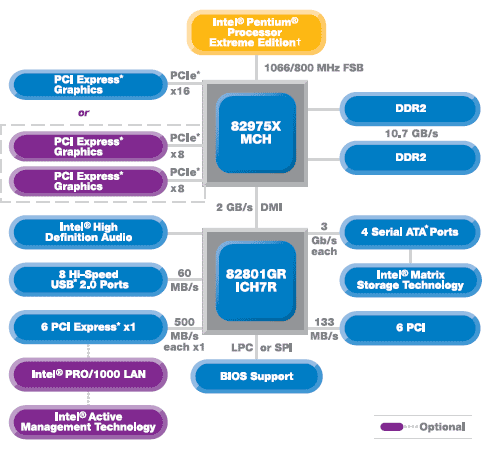Four 975X Motherboards For Core 2 Duo
Four For Core 2
Only few months ago, the processor landscape was very different than it is today: users favored AMD's Athlon 64 processor line because of its great performance and low heat generation. But the release of Intel's new processor changed everything: Core 2 duo is clearly the better processor, being both faster and more efficient.
However, Intel's renewed dominance does not turn the whole PC landscape upside down; there are still many scenarios in which an AMD system may be the better choice, even if it won't beat the best processor that is available. After all, if you want Core 2 Duo, you will have to pay a little premium, while AMD has cut prices on Athlon 64 processors to stay competitive. As a result, many Athlon 64 X2 systems still are more affordable than comparable Core 2 Duo machines.
So, should you go for a Core 2 Duo system today? The answer can only be "not necessarily". If you have a limited budget, it makes little sense to buy into Core 2 at all costs. If you want a machine that is future-proof, both AMD's socket AM2 platform and Intel's socket 775 will still be around for some time. AMD will introduce 65 nm processors soon and Intel is getting ready to deploy its first quad-core silicon, all of which will fit into existing platforms. However, If you don't mind spending extra money on the processor and a bit more on the motherboard as well, the Core 2 machine will be the better performer overall.
The Intel 975X Platform

There are only two high-end core logic products for socket 775 available: Nvidia's nForce 590 SLI chipset, and Intel's 975X. Both support all current processors, and high-end motherboards come with comparable feature sets. You need the Nvidia chipset to install an Nvidia SLI dual graphics solution, or the 975X to run an ATI Crossfire dual graphics setup. (It's ironic to see an ATI setup running on an Intel system these days, because the Canadian graphics company was recently purchased by AMD.)
The 975X is Intel's state-of-the-art core logic for high-end desktop and entry-level workstation systems. It supports all socket 775 Pentium 4, Pentium D, Core 2 Solo and Core 2 Duo processors at FSB800 and FSB1066 speeds, and it comes with a Dual DDR2-800 memory controller. As already mentioned, the chipset will support two graphics cards, each running at PCI Express x8 link speed, or the graphics interface can be configured to support a single graphics card at x16 link speed.
For device connectivity, Intel uses its well-known ICH7R Southbridge component, which supports High Definition audio, eight USB 2.0 ports, six x1 PCI Express lanes, a conventional PCI bus and four Serial ATA/300 ports for hard drives and modern optical drives. There is also one UltraATA/100 channel for your legacy devices, and Intel has implemented its Matrix Storage technology, which allows you to install multiple RAID sets across a common set of hard drives.
Core 2 Duo Requires New Motherboards
Unfortunately, you cannot run a Core 2 Duo processor on existing 975X motherboards, because the new processor requires a new platform feature. To make the situation worse, Intel did not adjust the chipset product name - perhaps because no major changes were made - which makes it very difficult to judge whether a given 975X motherboard will support Core 2 Duo or not. You will have to look at the motherboard revision level and the BIOS version, and search for processor support information on the website of the motherboard vendor whose product you're interested in.
Stay on the Cutting Edge
Join the experts who read Tom's Hardware for the inside track on enthusiast PC tech news — and have for over 25 years. We'll send breaking news and in-depth reviews of CPUs, GPUs, AI, maker hardware and more straight to your inbox.
Core 2 Duo uses three processor pins for Its Platform Environment Control Interface (PECI) feature, which allows the system to control case fans. Every Core 2 Duo processor has several digital temperature sensors that are processed by a manager chip; fan speeds are set depending on component temperatures. Unfortunately, only Intel's 975X motherboard was capable of supporting this feature.
Current page: Four For Core 2
Next Page Asus P5W DH Deluxe: The Flagship, Slightly Off CourseMost Popular

